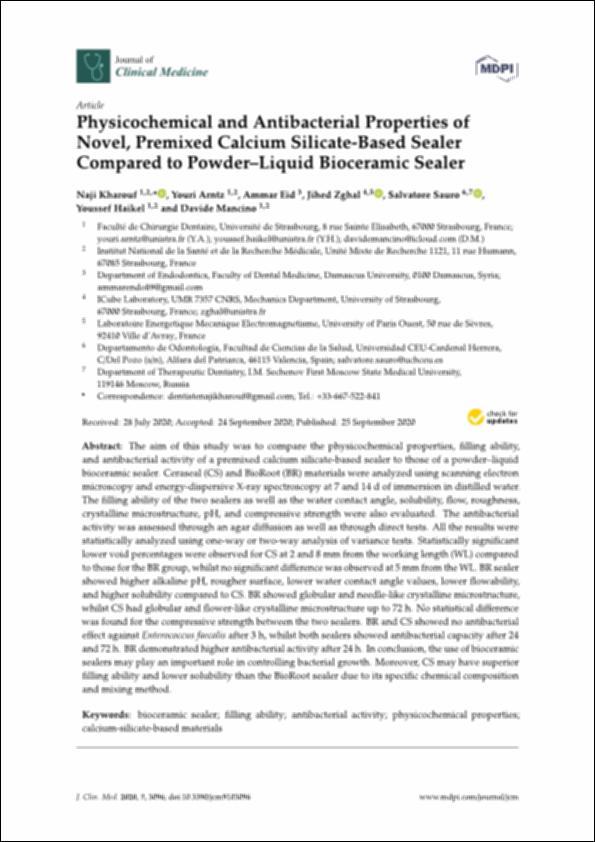Please use this identifier to cite or link to this item:
http://hdl.handle.net/10637/12562Physicochemical and antibacterial properties of novel, premixed calcium silicate-based sealer compared to powder-liquid bioceramic sealer
| Title: | Physicochemical and antibacterial properties of novel, premixed calcium silicate-based sealer compared to powder-liquid bioceramic sealer |
| Authors : | Kharouf, Naji Arntz, Youri Eid, Ammar Zghal, Jihed Sauro, Salvatore. Haikel, Youssef Mancino, Davide |
| Keywords: | Materiales dentales - Propiedades.; Gums and resins in Dentistry.; Gomas y resinas - Aplicaciones en Odontología.; Dental materials - Properties.; Dentistry, Operative.; Teeth - Roots - Planing.; Dientes - Cavidades - Preparación.; Odontología restauradora. |
| Publisher: | MDPI |
| Citation: | Kharouf, N., Arntz, Y., Eid, A., Zghal, J., Sauro, S., Haikel, Y. et al. (2020). Physicochemical and antibacterial properties of novel, premixed calcium silicate-based sealer compared to powder–liquid bioceramic sealer. Journal of Clinical Medicine, vol. 9, i. 10 (25 sep.), art. 3096. DOI: https://doi.org/10.3390/jcm9103096 |
| Abstract: | The aim of this study was to compare the physicochemical properties, filling ability, and antibacterial activity of a premixed calcium silicate-based sealer to those of a powder–liquid bioceramic sealer. Ceraseal (CS) and BioRoot (BR) materials were analyzed using scanning electron microscopy and energy-dispersive X-ray spectroscopy at 7 and 14 d of immersion in distilled water. The filling ability of the two sealers as well as the water contact angle, solubility, flow, roughness, crystalline microstructure, pH, and compressive strength were also evaluated. The antibacterial activity was assessed through an agar di usion as well as through direct tests. All the results were statistically analyzed using one-way or two-way analysis of variance tests. Statistically significant lower void percentages were observed for CS at 2 and 8 mm from the working length (WL) compared to those for the BR group, whilst no significant di erence was observed at 5mmfrom the WL. BR sealer showed higher alkaline pH, rougher surface, lower water contact angle values, lower flowability, and higher solubility compared to CS. BR showed globular and needle-like crystalline microstructure, whilst CS had globular and flower-like crystalline microstructure up to 72 h. No statistical di erence was found for the compressive strength between the two sealers. BR and CS showed no antibacterial e ect against Enterococcus faecalis after 3 h, whilst both sealers showed antibacterial capacity after 24 and 72 h. BR demonstrated higher antibacterial activity after 24 h. In conclusion, the use of bioceramic sealers may play an important role in controlling bacterial growth. Moreover, CS may have superior filling ability and lower solubility than the BioRoot sealer due to its specific chemical composition and mixing method. |
| Description: | Este artículo se encuentra disponible en la siguiente URL: https://www.mdpi.com/2077-0383/9/10/3096 Este artículo pertenece al número especial "Root Canal Treatment (RCT): latest advances and prospects". |
| URI: | http://hdl.handle.net/10637/12562 |
| Rights : | http://creativecommons.org/licenses/by/4.0/deed.es |
| ISSN: | 2077-0383 (Electrónico). |
| Issue Date: | 25-Sep-2020 |
| Center : | Universidad Cardenal Herrera-CEU |
| Appears in Collections: | Dpto. Odontología |
Items in DSpace are protected by copyright, with all rights reserved, unless otherwise indicated.


